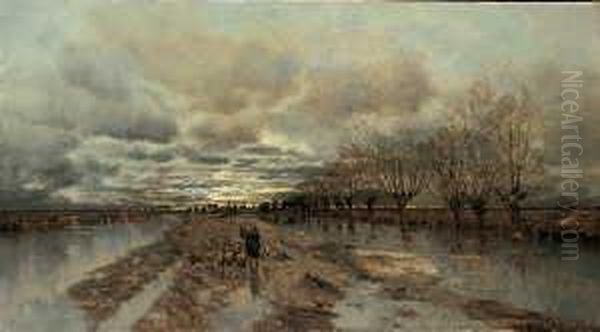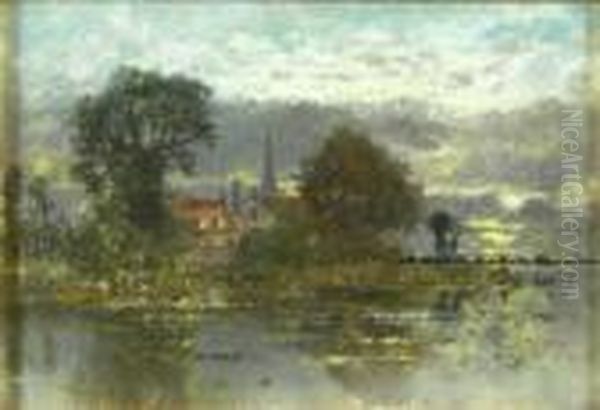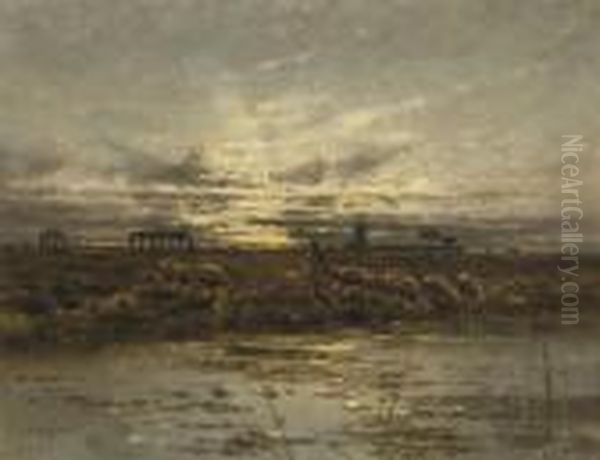Karl Heffner stands as a significant figure in German landscape painting during the latter half of the 19th and early 20th centuries. Born in Würzburg, Bavaria (not Württemberg as sometimes mistakenly cited) in 1849, and passing away in Berlin in 1925, Heffner dedicated his artistic career primarily to capturing the nuances of nature. His works, predominantly landscapes depicting tranquil lakes, evocative coastlines, and serene rural settings, earned him considerable acclaim during his lifetime, positioning him as a respected artist both within Germany and internationally. Though perhaps less widely known today than some of his modernist contemporaries, his paintings offer a compelling window into the sensibilities of late German Realism and the atmospheric landscape tradition.
Early Life and Artistic Formation
Karl Heffner's journey into the world of art began in his birthplace, the historic city of Würzburg in northern Bavaria. While specific details about his earliest artistic inclinations or training in Würzburg remain somewhat scarce in readily available records, it is clear that his path led him to Munich, which was then a major hub for artistic training and innovation in Germany. The Munich Academy and the city's vibrant art scene attracted aspiring painters from across Europe.
In Munich, Heffner sought out instruction that would shape his future direction. He is known to have studied under, or been significantly influenced by, prominent landscape painters active in the city. Among the key figures often associated with his development are Adolf Stademann (1824-1895) and Adolf Lier (1826-1882). Both Stademann and Lier were respected landscape artists themselves, known for their atmospheric depictions of Bavarian scenery, often focusing on capturing specific moods and light conditions, particularly winter scenes or twilight moments. Their guidance likely provided Heffner with a strong foundation in landscape painting techniques and fostered his sensitivity to the subtleties of light and atmosphere.
Development of Style: Barbizon and Beyond

Heffner's artistic development did not occur in isolation. Like many European artists of his generation, he looked beyond his immediate surroundings for inspiration. The influence of the French Barbizon School is particularly evident in his work. Active from the 1830s to the 1870s, painters like Jean-Baptiste-Camille Corot, Charles-François Daubigny, and Théodore Rousseau rejected Neoclassical formalism and Romantic melodrama, advocating instead for a more direct, realistic, and often intimate portrayal of the landscape, frequently painting en plein air (outdoors) to capture natural light effects more accurately.
Heffner absorbed these principles. His paintings often share the Barbizon painters' focus on tonal harmony, subtle colour palettes, and the evocation of mood over precise topographical detail. He became particularly adept at capturing the quiet poetry of nature, favouring scenes imbued with a sense of tranquility, melancholy, or gentle solitude. His handling of light, especially during transitional times of day like dawn, dusk, or under overcast skies, became a hallmark of his style. This approach aligns him with the broader European movement towards Realism and Naturalism in landscape painting.
Furthermore, Heffner was an extensive traveller. His journeys took him beyond Germany to England, Italy (including Rome, Naples, and Venice), the Netherlands, and even Norway. These travels provided him with a rich variety of subjects and further broadened his artistic perspective. The flat, watery landscapes of the Netherlands and the coastal regions of England, particularly areas like the Norfolk Broads, became recurring themes in his oeuvre, allowing him to explore different qualities of light and atmosphere associated with these specific environments.
Themes and Subjects
Karl Heffner's primary focus remained steadfastly on landscape throughout his career. He demonstrated a particular affinity for watery environments – rivers winding through meadows, quiet canals reflecting overcast skies, expansive lakes under dramatic sunsets, coastal marshes, and shorelines dotted with fishing boats. While he painted scenes from his travels across Europe, Bavarian landscapes and the scenery of Northern Germany also featured prominently.
His works often depict nature in its more subdued and tranquil states. He seemed less interested in dramatic Alpine vistas or sun-drenched Mediterranean brilliance than in the subtle interplay of light, water, and sky found in flatter terrains or during quieter times of day. Titles of his works often reflect these preferences: Kanallandschaft (Canal Landscape), Evening on the Tiber, Sunset over a Dutch Canal, Norfolk Broads, Roman Campagna, and Fishing Boats at Low Tide. These titles underscore his preoccupation with specific locations and atmospheric conditions.

Human presence in his landscapes is typically minimal and subordinate to the natural setting. Figures, when included, such as fishermen in his coastal scenes like Englische Küste mit Fischern (English Coast with Fishermen), often serve to provide scale or add a touch of narrative interest without dominating the composition. Their presence reinforces the sense of everyday life unfolding within the vastness of the natural world. The overall impression is one of harmony between humanity and nature, observed with a quiet, contemplative gaze.
Technique and Approach
Heffner developed a distinctive technique suited to his artistic aims. His brushwork could be relatively broad and fluid, particularly in rendering skies and water, allowing him to capture effects of light and reflection efficiently. However, he was also capable of finer detail where necessary, such as in the depiction of foreground vegetation or distant architectural elements. His approach was grounded in careful observation, likely supplemented by plein air sketching, even if final works were completed in the studio.
His use of colour was often characterized by tonalism. Rather than employing the bright, broken colours associated with French Impressionism (though he was a contemporary of artists like Claude Monet), Heffner favoured more muted palettes and subtle gradations of tone to build atmosphere and depth. Grays, greens, blues, and earthy browns often dominate his canvases, creating a sense of unity and mood. He excelled at depicting the diffused light of hazy mornings, the warm glow of sunset, or the silvery reflections on calm water under cloudy skies.
This focus on mood and atmosphere places Heffner within the German tradition of Stimmungsimpressionismus (Mood Impressionism). This was less a formal movement and more a tendency among certain late 19th-century German painters who adopted some Impressionistic techniques (like looser brushwork and attention to light) but prioritized the subjective emotional response and overall atmospheric feeling of a scene over the purely objective recording of visual sensations sought by their French counterparts. Heffner became a master of this evocative approach.
Career and Recognition
During his lifetime, Karl Heffner achieved significant professional success and international recognition. He was a regular exhibitor at major art venues, including the prestigious Munich Glaspalast (Glass Palace) exhibitions, the Berlin Academy exhibitions, the Vienna Künstlerhaus, and internationally at the Paris Salon and the Royal Academy in London. His participation in these prominent shows exposed his work to a wide audience and garnered critical attention.

His atmospheric landscapes resonated with the tastes of the time, and he found favour with collectors and even royalty. Notably, King Ludwig II of Bavaria, known for his patronage of the arts (particularly Richard Wagner), acquired works by Heffner. This royal patronage undoubtedly enhanced his reputation. He received various medals and honours for his paintings at different exhibitions, cementing his status as a leading landscape painter of his generation in Germany.
He operated within a vibrant German art scene that included established figures like the Düsseldorf School landscape painters Andreas Achenbach and Oswald Achenbach, known for their more dramatic and detailed styles, as well as contemporaries like Hans Thoma, who focused on idyllic German landscapes often imbued with symbolic meaning. Later in Heffner's career, artists like Max Liebermann and Lovis Corinth would emerge, pushing German art towards Impressionism and Expressionism, respectively. Heffner, however, largely remained true to his established style rooted in Realism and atmospheric sensitivity. His international success also placed him in dialogue with landscape traditions elsewhere, such as the Hague School in the Netherlands, whose artists like Jacob Maris, Willem Maris, and Anton Mauve shared a similar interest in tonalism and atmospheric depictions of local scenery.
Later Years and Legacy
In his later years, Karl Heffner eventually moved from Munich to Berlin, another major German art center. He continued to paint and exhibit, maintaining his focus on the landscape themes that had defined his career. He passed away in Berlin in 1925, having witnessed enormous changes in the art world, from the dominance of academic Realism in his youth to the rise of various avant-garde movements.
Heffner's legacy is that of a highly skilled and sensitive painter of atmospheric landscapes. He represents a significant strand of German art in the late 19th century, one that valued mood, technical proficiency, and a deep connection to nature, influenced by but distinct from French Impressionism. While his style might have appeared conservative compared to the radical innovations of Expressionists like Ernst Ludwig Kirchner or the members of Die Brücke, who were active during the later part of Heffner's life, his work held considerable appeal for its poetic qualities and technical mastery.
His reputation, while strong during his lifetime, perhaps somewhat faded in the subsequent decades as art historical narratives increasingly focused on the pioneers of Modernism. However, his paintings remain appreciated by collectors and connoisseurs of 19th-century European art for their evocative beauty and skillful execution. He holds a secure place as a key representative of Stimmungsimpressionismus and late German Realist landscape painting.
The Art Market Today
In the contemporary art market, Karl Heffner's works appear regularly at auction, primarily in Germany and other European countries. His paintings generally achieve prices that reflect solid appreciation but do not typically reach the heights commanded by the leading French Impressionists or major figures of Modernism. Auction estimates and results often fall within the range of several hundred to several thousand Euros, depending on the size, quality, subject matter, and condition of the piece.
For example, specific works mentioned in auction records include Kanallandschaft, estimated at €1,000-€1,200, and Englische Küste mit Fischer, estimated at €800-€1,200. Another work, likely titled Brzezno jezioro (Lake Brzezno), dated 1884, reportedly sold for 5,000 Polish Złoty (roughly €1,100-€1,200) in June 2023. These figures suggest a consistent market interest among collectors specializing in 19th-century German landscape painting. While not reaching investment-grade prices seen for bigger names, his work is clearly valued for its aesthetic qualities and historical significance within its specific context. The current market value reflects a solid, if perhaps niche, appreciation, standing in contrast to the broader international fame he enjoyed during his peak years.
Conclusion
Karl Heffner was a dedicated and accomplished landscape painter whose career spanned a period of significant transition in European art. Rooted in the traditions of German Realism and deeply influenced by the atmospheric concerns of the Barbizon School, he forged a distinctive style characterized by tonal harmony, sensitive handling of light, and an ability to evoke profound moods through his depictions of nature. His favoured subjects – tranquil waterways, coastal scenes, and quiet rural landscapes from Germany, England, Italy, and the Netherlands – were rendered with technical skill and a poetic sensibility.
Achieving considerable international success and recognition during his lifetime, including royal patronage, Heffner stands as a key figure in the Stimmungsimpressionismus tendency within German art. While his fame may have been partially eclipsed by the rise of Modernism, his works continue to be appreciated for their quiet beauty and masterful capture of atmosphere. He remains an important artist for understanding the nuances of landscape painting in late 19th and early 20th-century Germany, a bridge between earlier Realist traditions and the changing artistic currents of the turn of the century. His paintings endure as testaments to a deep and abiding engagement with the natural world.